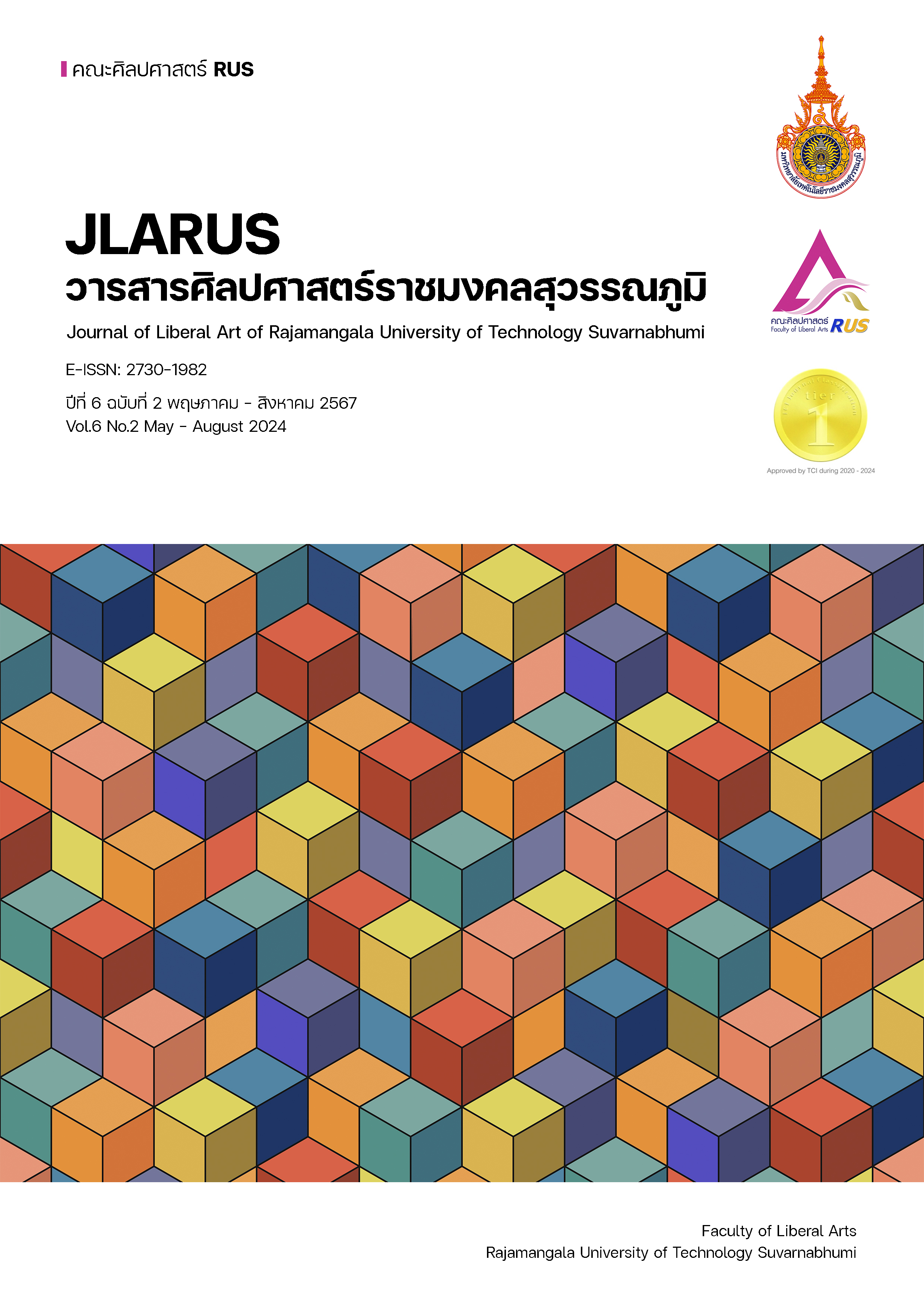INNOVATIVE PARTICIPATORY COMMUNICATION PROCESSES WITHIN THE DIGITAL ORGANIZATION TO PROMOTE ADMINISTRATIVE EFFICIENCY OF THE NONTHABURI CHAMBER OF COMMERCE
Main Article Content
Abstract
This research has the objective: 1) to study the current communication format within the Nonthaburi Chamber of Commerce organization, 2) to study the problems and obstacles of communication within the Nonthaburi Chamber of Commerce organization, and 3) to create innovative participatory communication processes within the digital organization to promote administrative efficiency of the Nonthaburi Chamber of Commerce. The research employed qualitative research methodology by means of in-depth interviews and focus group. The 24 key informants consisted of 10 key informants chosen from in-depth interviews and 14 focus group participants.
The results of the research found that: 1) The current communication format within the Nonthaburi Chamber of Commerce organization consists of 3 formats that promote the management efficiency of the Chamber of Commerce, including 1) listening to opinions through members and stakeholders 2) having chamber meetings regularly and 3) disseminating information through various media accessible. 2) Problems and obstacles of communication within the Nonthaburi Chamber of Commerce organization, Nonthaburi Chamber of Commerce are caused by the way operators often not raising those problems to ask for advice or openly discussing them as well as Ignoring and hiding the problem even these problems and obstacles can solve by talking and communicate more about every issues together with emphasizing on meeting to exchange views, and 3) Innovative participatory communication processes within the digital organization to promote administrative efficiency of the Nonthaburi Chamber of Commerce are began with the management of the Chamber of Commerce organization giving importance to communication both inside and outside the organization through policies and various news to those involved and to the operators and related people. The appropriate communication channel is having digital technology as a part of communication.
Article Details

This work is licensed under a Creative Commons Attribution-NonCommercial-NoDerivatives 4.0 International License.
References
กมลรัฐ อินทรทัตน์. (2547). การสื่อสารกับการพัฒนา. นนทบุรี: มหาวิทยาลัยสุโขทัยธรรมาธิราช.
กระทรวงศึกษาธิการ. (2551). หลักสูตรการศึกษาขั้นพื้นฐาน พุทธศักราช 2551. กรุงเทพมมหานคร: โรงพิมพ์คุรุสภาลาดพร้าว.
กาญจนา แก้วเทพ. (2543). การสื่อสารกับชุมชน: แนวคิดหลักเพื่อการพัฒนา. วารสารนิเทศศาสตร์, 18(2), 61-77.
กิดานันท์ มลิทอง. (2548). เทคโนโลยีการศึกษาและนวัตกรรม. กรุงเทพมมหานคร: อรุณการพิมพ์.
จิรพงษ์ เทียนแขก และพิษณุ บุญนิยม. (2565). การสื่อสารภายในองค์กรเพื่อการบริหารงานของ คณะมนุษยศาสตร์และสังคมศาสตร์มหาวิทยาลัยราชภัฏกำแพงเพชร. วารสารพิกุล, 20(2), 165-182.
ณัฐวุฒิ เอี่ยมเนตร, สุวลังก์ วงศ์สุรวัฒน์, พระครูปลัดประวิทย์ วรธมฺโม, นภัทร์ แก้วนาค, และจิดาภา เร่งมีศรีสุข. (2567). นวัตกรรมการสื่อสารเพื่อการส่งเสริมการบริหารจัดการองค์กรภาครัฐและภาคเอกชนในยุคดิจิทัล. วารสารนวัตกรรมการจัดการศึกษาและการวิจัย, 6(1), 291-302.
นิติพล ภูตะโชติ. (2556). พฤติกรรมองค์การ. กรุงเทพมมหานคร: วี พริ้นท์.
นิภาพรรณ โสพัฒน์. (2562). วิธีการสื่อสารในองค์กรที่มีประสิทธิภาพ. วารสารสมาคมพัฒนาวิชาชีพการบริหารการศึกษาแห่งประเทศไทย, 1(3), 23-30.
นภัทร์ แก้วนาค . (2555). เทคนิคการวิเคราะห์ข้อมูล (Qualitative Data Analysis Technic). เอกสารประกอบการสอนหลักสูตรการวิจัยและพัฒนาหลักสูตร. กรุงเทพมมหานคร:มหาวิทยาลัยศรีนครินทรวิโรฒประสานมิตร.
บุญเทิด อุทยานิน, กิ่งเพชร ส่งเสริม, สมพงษ์ ธงไช และปิยศักดิ์ สีดา. (2562). ความหลากหลายทางเทคโนโลยีวัฒนธรรมการสื่อสารในยุคปัจจุบัน. วารสารคณะมนุษย์ศาสตร์และสังคมศาสตร์มหาวิทยาลัยราชภัฎศรีสะเกษ, 3(1), 7-19.
ประพจน์ ณ บางช้าง, วิโรจน์ ศรีหิรัญ, และสุวิมล อาภาผล. (2564). การพัฒนานวัตกรรมีการสื่อสารแบบมีส่วนร่วมของชุมชนเพื่อส่งเสริมีการท่องเที่ยวเชิงสร้างสรรค์อย่างยั่งยืนของจังหวัดระนอง. วารสารนิเทศศาสตรปริทัศน์, 25(3), 156-167.
ปรมะ สตะเวทิน. (2546). หลักนิเทศศาสตร์. กรุงเทพมมหานคร: ภาพการพิมพ์.
พวงชมพู ไชยอาลา แสงรุ่งเรืองโรจน์. (2556). การสื่อสารแบบมีส่วนร่วม: กลไกในขับเคลื่อนแนวคิดสู่การปฏิบัติภายใต้กระบวนทัศน์การพัฒนาแบบทางเลือก. วารสารมนุษยศาสตร์สังคมศาสตร์ มหาวิทยาลัยขอนแก่น, 30(2), 23-42.
สมพงษ์ เส้งมณี, วิฆเนศวร ทะกอง, เสาวนีย์ วรรณประภา, ภารดี พึ่งสำราญ และกาญจนา สมพื้น. (2564). การสื่อสารแบบมีส่วนร่วมเพื่อพัฒนาการท่องเที่ยวชุมชน กรณีศึกษาหมู่บ้านเสม็ดงาม จังหวัดจันทบุรี. วารสารสหวิทยาการสังคมศาสตร์และการสื่อสาร, 4(2), 69-79.
สัญชาติ พรมดง, นันทนา นิจจอหอ และนาถรพี ชัยมงคล. (2561). การสร้างประสิทธิภาพของการสื่อสารภายในองค์กรเพื่อเพิ่มความสามารถในการแข่งขันทางธุรกิจ. วารสารเครือข่ายส่งเสริมการวิจัยทางมนุษยศาสตร์และสังคมศาสตร์, 1(1), 50-59.
สุนีย์ สว่างศรี, ขันทอง วัฒนะประดิษฐ์ และพระปราโมทย์ วาทโกวิโท. (2566). กระบวนการสันติ นวัตกรรมการสื่อสารที่เสริมพลังอำนาจผู้นำวิถีชีวิตใหม่. วารสารสันติปริทรรศน์ มจร, 11(1), 368-380.
สุรินทร์ทิพ ศักดิ์ภูวดล. (2563). การบริหารองค์กรดิจิตอล. พะเยา: มหาวิทยาลัยพะเยา.
Cornelissen, J. (2008). Corporate Communication A guide to theory and practice. London: SAGE.
Deloitte. (2018). Activating the digital enterprise: A sink-or-swim moment for today's enterprise. Retrieved August 12, 2023. from https://www2.deloitte.com/us/en/ pages/human-capital/articles/thedigital-organization.html.
Gallup. (2012). Employee engagement. Retrieved August 15, 2023 from http://www. gallup.com/consulting/52/employee-engagement.aspx.
Meyer, J. P., & Allen, N. J. (1991). A three-component conceptualization of organizational commitment. Human resource management review, 1(1), 61-89.
Thayer, L. (1961). Administrative Communication. Illinois: Richard D. Irwin.
The Joint Commission. (2010). Advancing Effective Communication, Cultural Competence, and Patient- and Family-Centered Care: A Roadmap for Hospitals.
Tourish, D., & Hargie, O. (2004). Motivating critical upward communication: a key challenge for management decision making. In Key issues in organizational communication. Routledge.
United Nations. (1983). Popular Participation as a Strategy for Promoting Community
Level Action and Nation. New York: United Nations.
Verghese, A. K. (2017). Internal Communication: Practices and Implications. SCMS Journal of Indian Management, 14(3).
Welch, M., & Jackson, P. R. (2007). Rethinking internal communication: a stakeholder approach. Corporate communications: An international journal, 12(2), 177-198.
Zaremba, A. J. (2010). Organization Communication (3rd ed.). New York: Oxford University Press.
White, M. D., Fyfe, J. J., Campbell, S. P., & Goldkamp, J. S. (2003). The police role in preventing homicide: Considering the impact of problem-oriented policing on the prevalence of murder. Journal of research in crime and delinquency, 40(2), 194-225.
Berlo, D. K. (1960). The Process of Communication. New York: Rinehart and Winston.
Berman, S. J. (2012). Digital transformation: opportunities to create new business models. Strategy & Leadership, 40(2), 16-24.
Vaz, N. (2021). Digital business transformation: How established companies sustain competitive advantage from now to next. John Wiley & Sons.
Perkin, N., & Abraham, P. (2017).Building the Agile Business through Digital Transformation. London: Koganpage.
Berelson, D. (1952). Content Analysis in Communicative Research. New York: The Free Press.
Holsti, O. R. (1969). Content Analysis for the Social Science and Humanities. Massachusetts: Addison–Wesley.
Denzin, N. K. (1970). The research act. Chicago, IL: Aldine.


